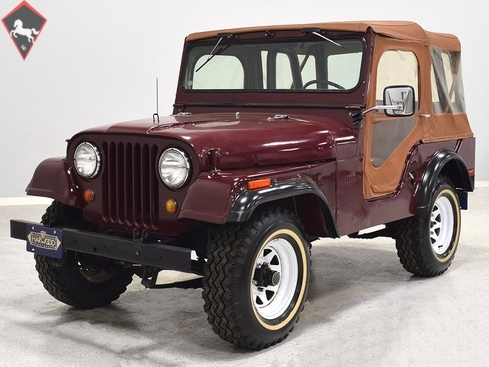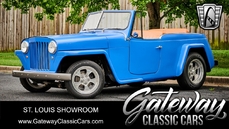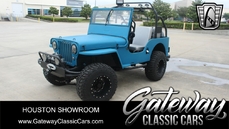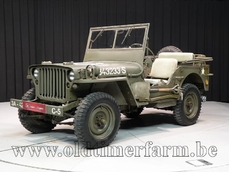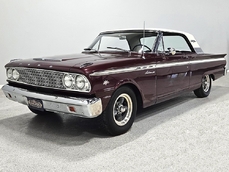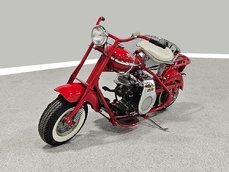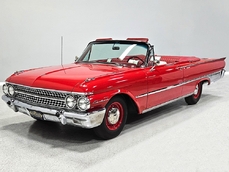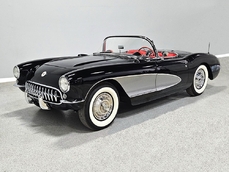Willys Jeep 134 cubic inch inline-4 1965
Allgemeine Beschreibung :
Older amateur restoration of a pre-AMC Jeep CJ5. Runs and drives great, recent top and doors, upgraded stereo. Nice color combination on a traditional Jeep. If you have somewhere remote to go and want to have fun doing it, this Jeep is the answer.
The restoration was finished in the ‘80s, so it’s not fresh, but you can tell this Jeep has been loved. It’s not perfect, of course, but it has clearly been used as intended: having adventures in remote places. We have a fairly large stack of receipts on the restoration, and they covered all the big stuff so it’s in good order. The paint has a decent shine and the bodywork is Jeep-appropriate—not perfect, but not at all rusted. Sure, there are a few signs of use, a few dings here and there, and plenty of off-road scars, but that’s how a Jeep should look, isn’t it? Perfection is over-rated and perfect Jeeps never get to have any fun in the mud. Instead, this one delivers fun all out of proportion to its price tag and the low-worries cosmetics mean that you can head out into the wilderness without guilt. The traditional Jeep styling cues are all there, from the seven-bar grille and round headlights to the folding windshield to the spare tire mounted out back. As I mentioned, there’s no critical rust or rot in the tub and it has that charming Jeep look that has been loved for decades. This is an affordable, easy way to get into the Jeep lifestyle.
The interior is bare-bones, make no mistake. If you want comfort and luxury, a Jeep isn’t a smart choice. But if you want the ability to go anywhere and just hose it out when you’re done, this is a great vehicle. The seat covers are in great shape and the tan upholstery is a nice contrast to the burgundy paint job. Rubber mats on the bare metal floors mean getting dirty shouldn’t be optional, and the three-spoke steering wheel probably dates to WWII. A full complement of gauges are arrayed ahead of the driver, along with a set of toggle switches for auxiliary functions like lights and wipers. There’s also a heater control unit under the dash and an ‘80s Alpine AM/FM/cassette head unit in the dash with speakers at either end. The shifter features a chrome knob, and controls a 3-speed manual transmission, with auxiliary levers for the transfer case and front axle. Seat belts were added during the restoration, which is probably not a bad idea, and the back seat looks almost completely unused. There’s also a recent tan top and doors which are easy to remove for the open-air Jeep experience.
Power comes from the familiar Kaiser/Willys 134 cubic inch “Hurricane” 4-cylinder engine. A powerhouse it isn’t, but it’s bulletproof reliable and it was built by guys who understood what a Jeep was designed to do. It starts easily with a gruff 4-cylinder bark from the tailpipe and there’s decent low-end torque to make it feel peppy around town. With plenty of gear in the transfer case, particularly low range, it’s still potent off road and will get you anywhere you need to go. There are lots of cool features, too, including the remote air filter that helps with deep water fording, a big heater unit on the driver’s side firewall, and a thick radiator designed for slow-speed work. The 3-speed transmission shifts nicely with light clutch action and in low range this thing has the moves of a mountain goat. The undercarriage is a bit grungy, but that only means it has been used for its intended purpose and again, there’s no serious structural rot that should cause any concern. Leaf springs ride reasonably well and offer surprising axle articulation, and the no-frills hardware means that low maintenance is the word of the day. 4-wheel drum brakes are plenty powerful for the Jeep’s modest performance and light curb weight, and it sits on familiar 15-inch steel wheels with ancient retro-cool L78-15 off-road whitewalls.
Extras include an Army service manual and a massive stack of receipts covering the last four decades.
Fun on a budget has always been Jeep’s strong suit, and this neat little CJ5 asks for very little in return for the smiles it delivers. Not perfect, but perfect for going on an adventure, it’s a great way to get into off-roading without a major investment. And no matter where you go, this little 4x4 generates smiles and good memories, so you’ll always be a celebrity when you drive it. Call today!
Harwood Motors always recommends and welcomes personal or professional inspections of any vehicle in our inventory prior to purchase.
1965 Willys Jeep 134 cubic inch inline-4 is listed zu verkaufen on ClassicDigest in Ohio by Harwood Motors for $11900.
Fakten der Auto
Karosserietyp : Auto Marke : Willys Modell : Jeep Ausführung : 134 cubic inch inline-4 Hubraum : 0.0 Modelljahr : 1965 Lage : Ohio Fahrzeug Anmeldung : Undefiniert
11900 $
People who viewed this Willys Jeep also viewed similar Willys listed at ClassicDigest
Other cars listed for sale by this dealer
über Willys
Die Willys-Overland Company, später einfach Willys genannt, war ein amerikanischer Automobilhersteller, der eine bedeutende Rolle in der Automobilgeschichte spielte. Hier ist ein Überblick über die Geschichte von Willys:Frühe Jahre:
Gründung: Das Unternehmen wurde 1908 von John North Willys in Toledo, Ohio, zunächst als Willys-Overland Motor Company gegründet. John Willys erwarb die Overland Automotive Division der Standard Wheel Company, die das Overland-Automobil herstellte.
Früher Erfolg: Willys-Overland war in den frühen 1910er Jahren erfolgreich und produzierte Fahrzeuge wie das Overland Model 79, das aufgrund seiner Erschwinglichkeit und Zuverlässigkeit ein beliebtes Auto war.
Erster Weltkrieg:
Militärverträge: Während des Ersten Weltkriegs sicherte sich Willys-Overland bedeutende Verträge zur Lieferung von Fahrzeugen für die Kriegsanstrengungen. Die Produktionskapazitäten des Unternehmens waren für das Militär von entscheidender Bedeutung, da es Lastkraftwagen und Automobile für verschiedene Zwecke herstellte.
Einführung des Jeep:
Beitrag zum Zweiten Weltkrieg: Im Vorfeld des Zweiten Weltkriegs reagierte Willys-Overland zusammen mit anderen Automobilherstellern auf die Anfrage der US-Armee nach einem leichten, geländegängigen Aufklärungsfahrzeug. Das Unternehmen entwickelte den Willys MB, der zum legendären Jeep wurde.
Jeep Legacy: Der Jeep spielte mit seiner Robustheit, Vielseitigkeit und Zuverlässigkeit eine entscheidende Rolle im Zweiten Weltkrieg. Sein Erfolg führte zur Gründung der Marke Jeep, die für die Herstellung von Geländefahrzeugen bekannt ist, die sowohl im militärischen als auch im zivilen Bereich an Popularität gewannen.
Die Nachkriegszeit:
Zivile Jeep-Modelle: Nach dem Krieg führte Willys zivile Versionen des Jeeps ein, wie die CJ-Serie (Civilian Jeep), die eine Adaption des Willys MB aus Kriegszeiten darstellte. Diese Fahrzeuge wurden für den Offroad- und Freizeitgebrauch beliebt.
Willys' Entwicklung und spätere Jahre:
Eigentümerwechsel: Willys-Overland geriet in finanziellen Schwierigkeiten und wechselte in den Nachkriegsjahren mehrmals den Eigentümer, bis es schließlich zur Kaiser-Jeep Corporation wurde, nachdem es in den 1950er Jahren von Kaiser Motors übernommen wurde.
Ende von Willys: 1970 erwarb die American Motors Corporation (AMC) Kaiser-Jeep. Das Willys-Namensschild verschwand allmählich, als sich AMC auf die Marke Jeep konzentrierte. Später erwarb Chrysler in den 1980er Jahren AMC und führte die Produktion und Entwicklung von Jeep-Fahrzeugen fort.
Vermächtnis:
Willys‘ Vermächtnis ist in erster Linie mit seinem Beitrag zur Automobilindustrie durch die Schaffung des Jeeps verbunden, eines Fahrzeugs, das die Mobilität während des Zweiten Weltkriegs veränderte und zu einer eigenständigen Kultmarke wurde. Der Ruf des Jeeps für Langlebigkeit, Vielseitigkeit und Geländetauglichkeit entstand durch die Innovationen und den Erfolg von Willys-Overland während des Krieges.
